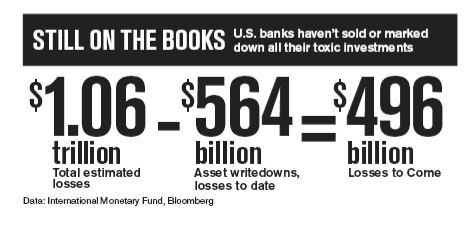You are here
Banks: Good News — and Bad Assets
Despite a comeback on Wall Street, the heaps of toxic debt aren't going anywhere. Be warned: Banking losses will be playing out for years
Regulators, investors, and policymakers are breathing a sigh of relief about the banks. Profits are up. Bank share prices are surging. And on June 9 Uncle Sam gave 10 banks the go-ahead to pay back $70 billion in bailout funds. "These are early signs of repair and improvement," Treasury Secretary Timothy F. Geithner said in a press briefing.
But tucked away on banks' books, a familiar problem remains: bad loans and the other toxic assets that plagued the markets for so long. That's terrible news for the economy. Even if the recession plays out as expected, the troubled investments will continue to sour, eroding banks' profits and hampering their ability to lend. "When you have to refill your capital base, you can't make new loans," says Elisa Parisi-Capone, the lead finance and banking analyst for RGE Monitor. "This is the definition of a zombie bank." The result could be a long, slow recovery.
The big fear, say analysts, is a repeat of last summer. Then, investors poured money into the banks, figuring the worst was over. But when Lehman Brothers failed and the bad assets tumbled in value, the banks burned through their newly raised capital. With the banks' capital depleted, the government had to come to the rescue. Says Marvin J. Miller Jr., a partner with law firm Winston & Strawn who specializes in bank financing: "The problem hasn't changed."
The conflicting reports and data on banks are baffling even the most astute observers. Sure, U.S. banks are in a better position than earlier this year. Since January, they've raised more than $200 billion, increasing their buffer against future losses. And financial firms have managed to sell more than $75 billion in debt without the added sweetener of a government guarantee, two-thirds of it in the last six weeks.
Regulators seem more confident about banks, too. The government's stress tests indicated the 19 biggest banks needed $75 billion of additional capital to withstand a tougher-than-expected recession. Even the Congressional Oversight Panel, a sometimes-acerbic bailout watchdog, offered modest praise for the tests.
But critics remain skeptical of some of the tests' underlying numbers. Under the worst scenario, the government assumed unemployment would average 8.9% in 2009 and hit 10.3% next year. In May the jobless rate reached 9.4%.
The tests also figured credit losses through 2010, implying the banks' bad assets won't deteriorate much beyond that date. But banks hold some $1 trillion in commercial real estate loans, according to a recent report by Deutsche Bank (DB)—and the bulk of the losses won't show up for a few years. Corporate loans, credit-card debt, and construction loans also continue to sour in the face of the recession.
Minor miscalculations in the stress tests could have major implications. Douglas Elliott, a former investment banker and currently a fellow at the Brookings Institution, says a mere 3% error in the estimated value of the banks' assets in 2010, for example, would mean another $300 billion shortfall in capital—on top of the $75 billion the government has required banks to raise. "If we found out afterward that [the capital hole] wasn't $75 billion but $375 billion, we would all feel differently," Elliott says.
Meanwhile, the banks' profits— another major factor in the stress tests—are built on a rather rocky foundation. For one, the banks got a big hand when regulators relaxed the accounting rules, which also helped them pass the stress tests. Now bankers can rely more on their judgment when valuing assets and less on gloomy market prices. The change—and other one-time boosts—helped big banks engineer a boffo quarter. Bank of America (BAC), for example, reported $4.2 billion in profits, while Wells Fargo (WFC) earned $3.05 billion.
Now, the banks have little incentive to dump their bad assets. If they did so, they might have to take a nasty hit to profits, prompting another round of high-stakes capital raising. "In many cases bankers are saying, 'I've got more upside than downside,' " says Wayne A. Abernathy, executive director for financial institutions policy and regulatory affairs at the American Bankers Assn., the industry trade group.
Officials at Treasury and the Federal Deposit Insurance Corp. would prefer that banks tackle the problem assets directly to help speed the sector's rebound. But the government shows no sign of pressuring them to purge their balance sheets. On June 3 the FDIC decided to table indefinitely a $250 billion program to buy bad loans. The U.S. figures its other efforts, slated to start this summer, will have a tepid response from potential participants.
Meanwhile, the bad loans and other dubious securities will burden banks—no matter which way the economy goes. By some estimates banks have nearly $500 billion in losses to work through if the recession unfolds more or less as projected. Looming losses will eat into future profits, as banks effectively earn their way out of the problem. In April the International Monetary Fund predicted writedowns at U.S. banks will exceed profits by almost $200 billion through 2010. "Concluding the banks are going to be able to survive is much different than concluding they have a level of soundness that will let them—and encourage them—to step up lending as we need them to do," says Brookings' Elliott. "This will be a drag on the recovery."
